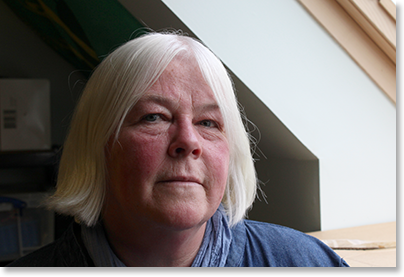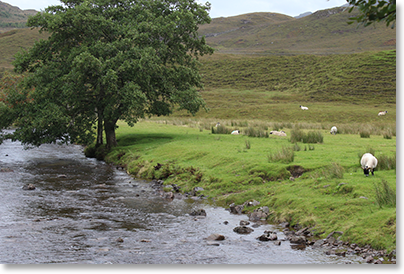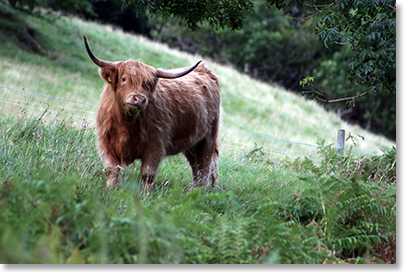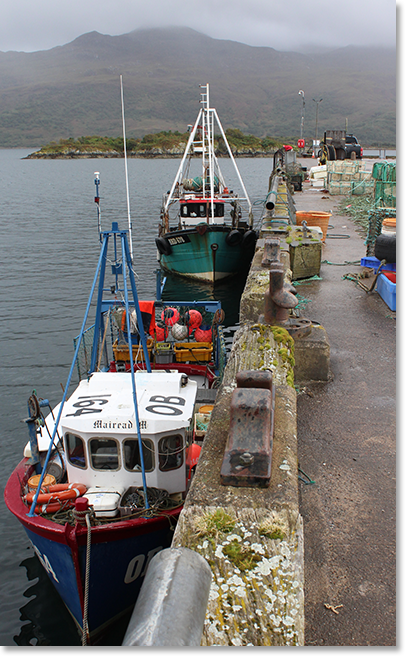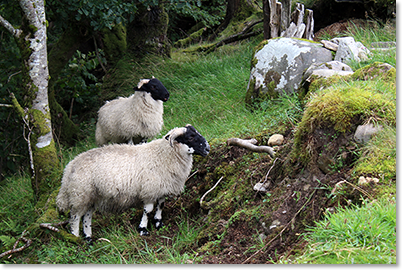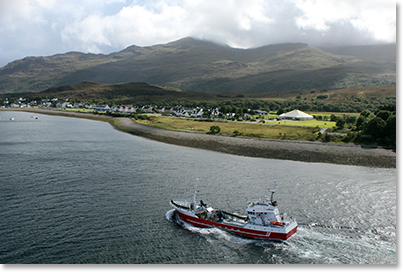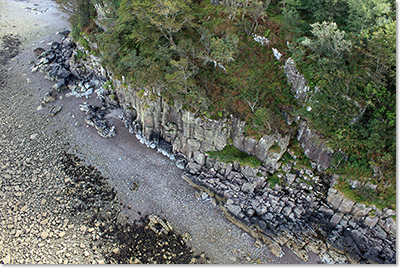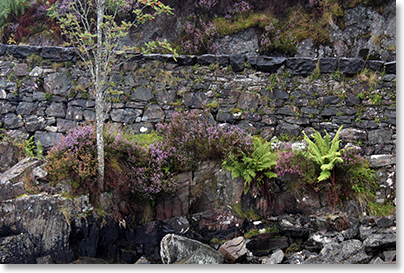|
Interview with Fiona Mandeville
This interview was conducted (and later edited) by Nic Paget-Clarke for In Motion Magazine on September 2, 2016. The interview took place in the offices of the Scottish Crofting Federation in Kyle of Lochalsh, on the northwest coast of Scotland.
Part 1: Why children in crofting areas need to be taught about crofting In Motion Magazine: Can you say a little about yourself and the Federation, please? Fiona Mandeville: I was one of the two members of staff of the organization when it first started and I worked there for seventeen years. I worked along with James Hunter who is a well-known historical author (editor: James Hunter wrote “The Making of the Crofting Community” and many other books about the people, culture, and history of the Highlands and Islands of Scotland). We set the organization up, and it’s continued since then. I never expected to find myself as chair of it. My term of office will be coming to an end in December of this year. I’ve done my two-year term and it’s been a great honor and privilege to do it. I never thought I’ve been the right person to be the chair but that is what came to be. I’m also editor of our periodical the Crofter. ... I’m not an employee of the Scottish Crofting Federation, I’m a volunteer. All the board, all the directors, people like Finlay, we are just volunteers. … we are largely funded just by membership subscription. We get grant funding for these projects that we initiate. For example, we have a training project, a big project, training in rural skills all across the Highlands and Islands. And we have another project called Crofting Connections, which is working with school children and teachers to teach children about crofting. This has been very popular. It has been going for at least six years now, possibly a bit more than that. You might question why children in crofting areas need to be taught about crofting. In generations gone by, they wouldn’t have needed to be taught about it in schools because they would have been participating in it throughout their day-to-day life at home. But that doesn’t happen quite so much now. (However,) we have been very encouraged that these young people are very interested in it -- these practical sessions, training sessions. They learn a lot from it and schools really like it and it’s energized and motivated the pupils to encourage them to be keen to learn more. They are just more motivated, more dynamic as a result of doing this. We think it is being outside and interacting with animals and growing potatoes and things like that, even learning about soil. Starting with the basics, you know. There’s the structure of soil, and about worms, the whole process. So, that’s been very popular. The most peripheral areas and the worst soil Some of the other things that we do are advocacy and lobbying. Obviously, political lobbying is very important because crofting is such a small-scale part-time activity that we have to fight very hard against the bigger commercial farmers, and most of the rest of Scotland and the UK (United Kingdom of Great Britain and Northern Ireland), to try and ensure that support schemes actually take account of crofting. Agricultural schemes have to be available to crofters as well as to the big farmers. The big farmers are very greedy and they want more and more and more money. The irony of the whole support structure at the moment is that wealthy farmers, with the best ground on the east and south of the country, get about ten times as much per hectare from EU (European Union) and UK budgets as crofters do in the most peripheral areas, with the worst soil, and the biggest productions costs, and the longest distances to market, and higher cost of living. But this is the reality of the support structure in the UK. We have a lot of contact with Europe through the likes of Via Campesina (Editor: La Vía Campesina is a worldwide organization of networks of farmers, peasants and Indigenous people) and we can see that the EU understands the situation of crofters much more, in some ways, than bigger farmers and the UK government do because small-scale farming, crofting as we have it here, is more common in many other European countries. The EU schemes have actually had a lot of potential to benefit crofting, but the Scottish government is much more influenced by the big farming lobbies who are bigger than us, more powerful. They employ dozens of professionals, staff, and lobbyists, and so on. They almost dictate to the government how these support schemes should work, and it’s always to the detriment of crofters. Part 2: The Communal Working of a Crofting Township The crofters were cleared Most crofters don’t own their land, they just rent their few acres or few hectares from an estate, from a rich -- well, the landowners wouldn’t say that they are rich -- but from people who own the land. Skye has about four or five different landowners that own the whole of the island of Skye, and they have tenant crofters on their estates. The crofters pay very minimal rent to the landowner annually and they have right of tenure. They can’t be moved off the land. This was an Act that was introduced in 1886. Back in the nineteenth century, people lived on estates and they were serfs enthralled to the landowners. In most cases, in these parts of the Highlands, this was the clan chiefs -- chief of Clan MacLeod on Skye, chief of Clan MacKinnon, chief of Clan Donald, MacDonald. Crofters had to do some work for the landlord. They had to do some fishing, some seaweed gathering, and they had very small bits of land which if they were lucky gave them a subsistence level of agricultural production just to feed the family. But, landlords came to realize that they could make more money from having sheep on their land -- so the crofters were cleared. First of all, to the very edges, the coastal strips of these estates where the land was usually poor. But many of them either chose or were forced to emigrate to Canada, or to the States, to Australia, and they went off in terrible conditions, squeezed into ships. Many of them didn’t survive. Those who did had to start a new life. Nova Scotia, for example, a lot of them went there and called it Nova Scotia. This eventually became known throughout the UK, it became a political issue, when a lot of crofters actually fought back against the government troops that were trying to dispossess them. An organization started up, the Highland Land League, and it raised the profile of these struggles, the Crofters’ Wars they were called. Eventually, the first Crofting Act was passed in 1886 and this gave crofters security of tenure so that they could no longer be cleared off their land, their crofts. Even though they didn’t own them, they were just tenants, they couldn’t be cleared off their land any more. A crofter has the right to pass the tenancy of his or her croft to a family member and that is incontestable. That is an absolute right. Since 1976, it has been possible for a crofter to buy his or her croft from the estate for not very much money. If a figure could be agreed, it was fifteen times the annual rent and the annual rent was just a very few pounds. My brother’s croft, for example, which is about seven acres, he paid until quite recently about seven pounds a year for that tenancy, and that’s fairly typical for croft rents here. Croft sizes vary across the crofting areas, across all the Highlands and Islands, and reflect the terrain to an extent. Some crofts are much bigger and some crofts are tiny. My own croft is very tiny indeed. It was created from part of another croft so the rest of that croft is tended by somebody else. I just got this croft about five, six years ago, and it’s quite possibly one of the tiniest crofts that there is. It’s really just an adjunct to my garden, to be honest. I hope eventually to have a tunnel greenhouse there and grow some vegetables, but at the moment I don’t have time to really do that because I have a fulltime job plus I do all the things I do for SCF and do various other community type things, as well. So, I don’t have a lot of free time. Living in the countryside Crofting is a whole range of activities, and a whole range of sizes of crofts, and a whole range of people. In times gone by, it was always local people: the MacDonalds, the MacLeods, the MacKinnons, as I mentioned. It was always indigenous peoples from the area that were crofters, but now that’s not the case categorically. A lot of people from elsewhere are attracted to the idea of living in the countryside and becoming a crofter. A lot of them want to escape from the challenges and the rat race of living in big cities down South. Somebody from London, for example, or some of these other big cities, can sell a small property there for a huge amount of money nowadays and buy something up here and live comfortably on the rest of selling their property down South. Some of these people get a croft, or they just buy a house, and some of them work the crofts. They learn how to be a crofter, basically, with the help of their neighbors. They work the croft and they provide a valuable input into the communal working of a crofting township – because that’s the other key thing about crofting. It’s a communal activity, to an extent, because, as well as the in-by land on which the croft house is, there’s a share in the common grazing which is usually a hill grazing where the stock are put in the summer so that the grass on the croft can grow and be made into hay, for example. Or some people might grow vegetables, and so on. The stock on the common grazing is managed communally by the crofters in the township, though that is not happening so much now. People have different lifestyles now and more people have a fulltime job and less time to actually get involved in communal activities and less time to croft at all. (Also), having sheep has become quite unprofitable because stock keeping responds to the nature of the support schemes and if there is not much support for keeping sheep then people will stop having sheep. Producers are very dependent on the support schemes -- the grants, the subsidies that come from the EU and the UK to help compensate for the cost of production. I don’t know how it works in the States, but in this country agriculture is subsidized. Agricultural production was encouraged after the Second World War. Producing more and more food was important, so a whole grant structure was brought into being to encourage people to do that – to produce as much as possible. And that has continued in one way or another since then and it just gets refined every change of government, every change of EU policy. Every few years slightly changes the support system and people respond to that and modify their agricultural production. In Motion Magazine: Do crofters become members or you simply represent the fact that crofters exist? Fiona Mandeville: Well, we do a bit of both. We would like all crofters to become members of our organization because we need their support, i.e. we need their subscriptions so that we can run the organization. But not all crofters do choose to become members. Some of them will be members of the Farmers Union because historically they might always have done that, or if they are bigger crofters that are more like farmers they might be a member of the Farmers Union. Some people join because they want to support, they appreciate and want to support the work that we do. Other people join because they want us to help with a specific problem of some sort. For example, we have a legal advisor from a firm of solicitors who will give basic legal advice, free if you are a member. In recent times, other people will join because they want to get a croft and we keep a list of crofts that are available. So, they will join because of that, but they tend to only last one year and then they don’t renew their membership. Other people will not bother joining but still expect us to work on their behalf for the good of crofting as a whole and we do do that because we are a charity. We do work for crofting generally as well as for crofters but we think there is a need for a representative organization, which is us, and we are the only representative organization exclusively for crofters. A degree of paternalism / abolished In Motion Magazine: The Crofters Act in 1886, was that a form of land reform? Fiona Mandeville: Yes, it was. Definitely. It was a very crucial land reform. You could say it was the beginning of empowerment of small-scale people on the ground. But it also, I suppose, introduced a degree of paternalism because the Crofting Commission is the government body that oversees crofting and administers it and deals with all the regulations. Some crofters feel that it’s very important to have the Crofting Commission to keep them right, to tell them how they should be doing things, to regulate crofting and to make sure everybody does the right thing. Other people (think) that the Crofting Commission should be abolished and crofters should be able to run their own affairs through a decision-making process. For example, when a tenant crofter wants to assign a tenancy to somebody else, that has to be approved by the Crofting Commission as it is at the moment. They will take into account (with) the potential new crofter: what they could do; how they would fit into the crofting community; (whether) they would bring some benefit to the township; do they know about agriculture and if not would they learn, and will they join in the cooperated learning? The cooperated working is getting less and less, which is a loss. Autonomy We think that people can definitely have more autonomy over their own affairs and should. But, particularly older crofters, some of them are a bit resistant to that. (But), getting back to land reform, back in the late eighties, Jim Hunter who I mentioned earlier, he felt very strongly that crofters should take more, have more say in running their own affairs and were more than capable of doing it. We persuaded the government to offer estates which it owns. The Scottish government owns some estates on Skye and Raasay and the Western Isles and some other places on the mainland. They are like the landowners of these estates and we persuaded them to give these estates over to crofters -- to take ownership of them basically, to run them themselves. And a trial was going to be on Raasay and some parts of Skye. There are some parts of Skye which are government-owned estates. But the crofters didn’t want it. They rejected the offer. Some of them felt that they weren’t able enough to do it. Others felt they wouldn’t be able to agree together, to actually run the estates successfully. A lot of people thought this was a really wasted opportunity. But, following on from that, after a period of years, we got to another stage of land reform in Scotland where (because of) a land reform Act of more than 10 years ago, crofting communities could buy out the estates of which they were tenants. And this was spear-headed by the Assynt Crofters Trust, up in Sutherland. The Assynt Crofters Trust The North Lochinver estate was owned by the Vestey family, very rich landowners, and some foreign people as well -- because anybody in the world can own land in Scotland and not even live in Scotland and still control the lives, to a certain extent, of the crofters who work the land. Anyway, the North Lochinver estate came on the market and it was going to be sold in small parcels, to lots of people who could afford to buy it. And several of our branch officials … they came together and decided that the crofters should try and buy this estate. So, they launched a big fundraising appeal and got world-wide notice for it and raised a huge amount of money. They raised enough money to buy this estate and that was the first crofting community estate. It’s called the Assynt Crofters Trust. That was a key moment in Scottish land reform -- an exemplar to other communities that this could happen. Now, a good number of crofting estates in particular areas have become crofting community trusts, particularly out in the Western Isles, in Lewis and Harris. Almost all now of Lewis and Harris is owned by crofters themselves. And that is partly because they had disinterested landlords who lived elsewhere, a lot of them down in England, for example. Just rich people who could buy an estate. It was like a plaything for them. They could go out and shoot a few deer once or twice a year. But there were always actually indigenous people who lived on the land and no development was happening. Nothing to benefit the local communities was happening because it was all controlled by somebody from somewhere else. So, crofters were resistant to that and as a result of funding assistance being made available -- the Labor government set the Scottish Land Fund -- and people fundrais(ing) as well -- huge amounts of donations -- there are now several crofting community estates. The crofters run these estates for the benefits of the communities who live there. They’ve set aside some land for affordable housing, for example. They’ve got wind-generation schemes. They’ve got hydro-schemes. They’ve got a workshop space available for people. Different things in different areas, depending what the local conditions are. It’s been very, very successful, in the main. In other areas, community buy-outs haven’t happened so much. Not just a community of crofters. It’s a crofting community Land reform has been very important in relation to crofting and continues to be so. But one slightly problematic area, perhaps, is the concept of a crofting community has changed slightly. Nowadays, it’s not just crofters who live in crofting communities. More and more people have moved in from elsewhere, as I said before. Now, it’s not just a community of crofters, it’s a crofting community. The people in that community are more than just crofters. So, when you get down to a local democratic level of decisions just to do what crofters want to do, they feel a bit threatened because there are all these other people living there and they don’t want them to have a majority say in how they as crofters should be managing their common grazing, for example. At a meeting the other day, (this was) one of their concerns, particularly in the area of Sleat, in the south of Skye. Over there, the population has increased hugely in the past twenty years, largely because a local landowner there, Sir Iain Noble, had the vision to have a Gaelic college established. It’s known as the Gaelic College (Sabhal Mòr Ostaig). It’s a college for further education which teaches in the medium of Gaelic and teaches rural skills and media studies and history, a whole range of things. It’s part of the University of the Highlands and Islands. There are a lot of good careers there now so there’s a lot more employment in that part of the island. Plus, climatically, it’s a slightly softer part of the island than some of the more rugged further north and west parts. It’s a very popular area for people to live in. So, a lot more people live there. It’s not just crofters there. There’s a lot of other people, professional people, and idealistic people, and what some of us cynically call born-again Gaels who don’t come from a Gaelic background at all but they are living there and they want to learn Gaelic and they put their kids into Gaelic medium schools. They are sort of obsessive about Gaelic, which they don’t pronounce very well, and make native speakers like my mother feel very uncomfortable hearing them speak. But they are very passionate about it. There’s a real mix of people living in that particular area, but some of the locals, the indigenous people, feel threatened by it. There is a big issue with people moving into the crofting areas from elsewhere and paying high prices both for land and for houses because it has inflated the housing market and young local people have not a hope in hell of actually being able to afford to buy a house. This is now the case throughout the country. Young people just can’t get a mortgage. They don’t earn enough to get a mortgage, to pay the high prices that you see on properties in London and a lot of the cities -- for the majority of the cities now in the UK, but particularly in England. So, there’s more and more people living in rented accommodation into their thirties and even into their forties. Social problems -- crofting can help deal with those Here, as well, there’s a lack of affordable housing because of the conservative initiative of Margaret Thatcher (Editor: UK Prime Minister, 1979-1990) where people who lived in council housing, or social housing of one sort or another, were given the right to buy their house that they’d been renting from the social provider for many years. That reduced the stock of affordable housing and not enough by a long way have been replaced. This is a problem of government policy on a large scale in the country and it affects people here. People here, young people, they end up living in caravans, in leaky old caravans, living throughout a rainy, windy winter here in a caravan. So, there’s a lot of social problems, as well, and crofting can help deal with those. If somebody can get a croft, if they meet criteria, they can get a grant to build a house on the croft and quite a lot of crofters build their own house, or contribute towards the building of it. The grant for croft housing was shown to be a very good use of public money to provide people with a home of their own. And, actually, better use of public money than building what we call council houses, here, you know, estates, social housing. But the grant level didn’t keep up with inflation. For a number of years now, (it) probably would contribute only half at most of the cost of building houses, so a crofter would have to get a mortgage as well to pay for the rest of it. And it’s hard to get a mortgage on croft land because the crofter doesn’t own the land. Lending agencies wouldn’t lend, wouldn’t give a mortgage to help pay for a croft house. There’s a lot of problems like that. Part 4: Women: The Croft Work and the Household Work As Well In Motion Magazine: So, there are some changes happening, that you are describing, positive ones, along with the problems. I’m just curious, what the role of women has been traditionally, and what you’ve noticed about the role of women in these changes. Fiona Mandeville: Women have always had an important role in crofting, but it was generally behind the scenes. They would have done a lot of the croft work, and the household work as well, but it was usually the man who was the tenant of the croft, not the woman. Only one person can be a tenant. And the croft tenancy was usually passed down from father to son. Even my own family, my brother -- I’ve only got one brother, he is younger than me -- in my father’s will he left the croft and the croft house to my brother, not to me as the oldest, and it wasn’t divided up or anything like that. It’s not a bone of contention at all, I just mention it as an example. It’s not unusual at all. It strikes me that the role of women in crofting is very much like the role of women in a lot of rural communities in any place I’ve been to and I’ve traveled a lot in Europe, and South Africa. The women just quietly get on with it in all these places and they do a lot of the donkey work while the men talk politics. I think that has been the case here too and any of the countries I’ve gone to. I’m always interested to try and get an understanding of how small farming works in these other countries, and sometimes the language can be a bit of a barrier, but I try and glean what I can and do a bit of research. Women have always been key, but on the sidelines. But nowadays a lot more women are the crofter in the family. Especially with the younger generation, women have a much stronger role. I think it’s all much more egalitarian now. (However) I was reading something about a township committee out in Lewis this morning and it was observed that there were no women in this township committee. It was all men that made the decisions and that I think would still be very typical in the Outer Hebrides in particular. But there’s definitely progress in women’s role in crofting society, in society generally. The women will do a lot but they will probably still do all the housework, and all the rest of it as well. The women have always been hands-on with the animals, the cows and the sheep, and they are probably more intuitive when it’s a calving or a lambing, and things like that. In Motion Magazine: Do you reach out to women as part of the Federation? Fiona Mandeville: To an extent. To be honest it’s not really something we’ve found necessary. When I first started editing The Crofter (the newsletter), somebody suggested it would be good to have a recipe column in it. So, I did that and some high-profile chefs were happy to write something, but I stopped doing it because I didn’t ever get any feedback that this was a good thing. We don’t have any specific articles for women in it but I think if you look through it you’ll see that there are as many women contributing to it as men. In crofting, generally, there are as many women as men doing things now. The role of women has not been an issue that has been brought to us. We try to have a gender balance on our board, for example, but in the old days the board was very much male dominated. I’m the third female chair of this organization, if I remember correctly. But there have been a lot more men that have been the chair and I suppose that has been an expectation. I’ve never felt disenfranchised as a woman either in crofting or in my life in any way. I don’t think many of my peer group do. But my mother, who is dead now, she died about three years ago, aged 93, she would always say, “Oh, I’m just a poor crofting cailleach.” Cailleach is the Gaelic for old lady. “Oh, I’m just a poor crofting cailleach, what do I know.” And yet she would go and dig the drains, clear out the drains to make sure that the land was draining properly. She was always doing things, but like most of her generation it was in the background. Part 5: Self-Reliance and Recovering from Oppression People work democratically and cooperatively, in the main In Motion Magazine: On your web site, and talking to people, a lot of it is about the crofting culture and in any kind of change, I am beginning to realize, it is more about culture than it is even about economics or these other things. What is crofting culture? Particularly what I’m trying to discover is the relationships among people. How is it different? Fiona Mandeville: The crofting culture is about different things but, just to try and answer your last point there, one of the key things about crofting is that people have to work together to manage the common grazings and that has been one of the key features of crofting which makes it fairly unique in the UK. Though there is common land in other parts of Scotland and in England as well, I don’t think the common working is quite as hands-on there as it is here. (Looking out the window) That hill there, for example, crofters’ sheep could be grazing on that hill and you can just imagine the amount of time and effort, and number of people and dogs would be required to gather the sheep in at times when they need to be. And there’s lots of hills like the one I’m describing. Communal gathering doesn’t happen quite so much now because there’s not so many sheep. The communal working aspect has been very important in the past and it’s strengthened the communities because it’s brought people together and people work democratically and cooperatively, in the main -- there’s always exceptions of course. It’s happening a bit less now. But in other ways, crofting culture is about the language, the heritage, the people. The language and the crofting culture is different in different parts of the crofting area. So, for example here, and in particular in the Western Isles, and up the west coast to an extent, it’s the Gaelic culture, the culture of the Gaels. But in Orkney and Shetland, it’s more of a Viking culture, without a doubt, and the nature of the people are different. Of course, the Shetlands were invaded by the Vikings and the Danes and so on and so they align themselves culturally more with Scandinavia and with Iceland. The way they speak is quite different. Very strong accents and some of the words are much more like Norwegian or Swedish words or Icelandic because they are from those roots. The people in the Northern Isles, in Shetland, I think they are more dynamic, they’ve got more get up and go, just a different breed of people. Again, I speak in generalities, but the west Highlands people are quieter, more self-effacing, have had a tendency to be more subservient –that’s less the case now. But it’s still there a bit. So, the crofting culture, just to try and summarize it: is about the language, it’s about the heritage, the shared history, and the sense of self-reliance and recovering from oppression. The communities are very strong and they have a lot of pride and people look out for each other and the people learn from each other. There’s a hegemony of helping and looking out for people. That is very different from large farms where there will be one owner or family might own it, or they might employ other people to work the land. That is what differentiates the big farms elsewhere from the small crofts here where one person or one family is battling against the elements, and the poor soil, and the high cost of living -- that’s where the self-help and the self-reliance (comes in). But the working together to solve problems is much more important. Part 6: A Landscape Managed by Crofters In order to make a living In Motion Magazine: Is there anything I haven’t asked that you think is important to say? Fiona Mandeville: Land use. The kinds of crofting that people do now can be different from how it used to be. It was always about sheep production and cattle production, or store cattle production, i.e. it’s not possible to grow enough crops to feed calves through the winter, so the calves usually get sold in the autumn. This year’s calves, born in the spring, will get sold in the autumn. They go on to be finished in the better farming land in the east or further south. Cattle dealers will buy all the calves from here, fatten them up, and sell them. The stock from here is generally healthier and disease-free. It has been grazed extensively with not a lot of chemical input, not a lot of steroids or anything like that. They are very natural and the quality of the meat is very high. Those two things, sheep and cattle production, were always the mainstay of crofting, but now people are diversifying a lot into things like forestry. It used to be that any trees that a crofter might plant on his or her croft, as soon as they got to a particular size they became the property of the landlord. So, there was no incentive for crofters to plant trees because they couldn’t harvest them or do anything with them. But, in the early ’80s, the Crofters Union, as it was then, with the help of an interested local MP (editor: Member of Parliament), we got a crofter forestry Act passed through Parliament which enabled crofters to own trees that they would plant. It was quite important to plant trees in this part of the world because there are not a lot of trees, and trees are good for all sorts of reasons. So, now, some people will grow trees. Other people will grow fruit if they can create the shelter and can improve their soil. People will go into bee keeping, into crafts of various sorts. There’s a whole range of diversifications; and there has always been a need for diversification. Other people will diversify into tourism, accommodation for tourists. There’s a whole range of things that crofters have to do in order to make a living. And the majority of crofters will also have a job. They don’t make enough income from working the land, so they have a job so they can actually have some money to spend on working the land. If that makes sense. It’s all pluriactivity and crofting is very important to sustain communities in these remote places. I mean you think we are remote here but there’s other places that are a lot more remote, -- I’m generally pointing west and north. Crofting is responsible for there being populations still in a lot of the peripheries of the Highlands and Islands. Stewards of the land And crofting is also good for the environment because of the extensive nature of production. There is not a lot of chemicals used to improve the land. Particularly out in the Western Isles, in the Machair, there’s a sandy grassland on the west coast is the last habitat of quite a number of rare plants and quite a lot of rare birds. They used to be prolific all across the UK but now only survive in the crofting areas. That reflects the farming practices there, the cultural practices of crofters. Birds like the corncrake only survive in crofting areas. In Motion Magazine: Would you say crofters are stewards of the land? Fiona Mandeville: Very much so. Yes, that’s one of our key themes actually, that crofters are the stewards of the land. And that’s why we think that the support system should recognize that more. Crofters should get more support as stewards of the land, for providing public goods, for providing the landscapes that tourists like to come and see and enjoy and being in amongst. But that doesn’t happen enough because any support for things like that is gobbled up by the rich farmers elsewhere who don’t need it but get it. In Motion Magazine: I’ve read about how Indigenous people in California for the last 10,000 years crafted entire landscapes. Do you think that happens here? Fiona Mandeville: Yes, yes. People from down South like to refer to the Highlands and Islands as a wilderness, but it’s not a wilderness, has never been a wilderness. It’s a landscape managed by crofters here. The crofting regimes that we have actually keep down the bracken. Things that we grow completely change the landscape. Yes, the indigenous people created and continue to manage the landscape that you see now. They continue to play an important role in doing that and need to be facilitated and encouraged and keep on doing it. It gets harder and harder to do because of people’s lifestyles -- young people have higher expectations of the kind of the level of comfort they should have. Some young people don’t want to be crofters because they know it’s hard work and not cost effective, and so on. We feel they need to be encouraged because they are providing a good for the other people of the rest of the country to enjoy and want to keep. To come into the “wilderness” Another problem that we have is reintroduced species. Sea eagles have been reintroduced to various parts of the Highlands and sea eagles will kill lambs, take then and eat them, or just kill them. And while theoretically there is compensation for that, it is not enough because you have to prove that is a sea eagle that has killed your lamb. Sometimes it is very hard. Or, if your lamb has just disappeared, you can’t prove it was a sea eagle, you just know you haven’t got the amount of stock that you expected to have. And again, people from down South think it’s wonderful to see the sea eagles. And it is wonderful to see them because they are huge, inspiring birds -- but they do kill sheep. And other people want wolves and lynx to be re-introduced in the Highlands so that they can come and look at them. The Highlands is their playground, as it were, and they think they have the right to come into these places. They live in cities. They want to escape from the cities for a day’s enjoyment in the outdoors and they would like to be able to see wolves and lynx. But wolves and lynx are going to take stock as well. They kill animals. My brother lives in Sweden a fair bit of the time. He has a croft locally, but he lives in Sweden where they do transhumance (editor: transhumance farming is care of livestock which involves farmers moving with the animals as seasons change) small-scale farming and they have a big problem with re-introduced wolves. The wolves have more protection than the fäbod farmers’ sheep (editor: transhumance farming is called fäbod farming in Sweden). They have to stand guard and make sure the wolves don’t get to the young calves because they’ll kill them. But they can’t shoot the wolves if they see one. They have to get a licensed hunter to come and do it and that can take days, by which time the wolves are likely to have moved on. So, it’s quite a problem, the aspirations of city people to come into the “wilderness,” in inverted commas, and see all the things that they think should be in the wilderness. But they don’t appreciate that people make their livelihoods from these areas. The folks from the cities can’t just foist their wishes onto the local indigenous people, or the people who live here. Also see:
|
||||||||||||||||||||||||||||||||||
If you have any thoughts on this or would like to contribute to an ongoing discussion in the  What is New? || Affirmative Action || Art Changes || Autonomy: Chiapas - California || Community Images || Education Rights || E-mail, Opinions and Discussion || En español || Essays from Ireland || Global Eyes || Healthcare || Human Rights/Civil Rights || Piri Thomas || Photo of the Week || QA: Interviews || Region || Rural America || Search || Donate || To be notified of new articles || Survey || In Motion Magazine's Store || In Motion Magazine Staff || In Unity Book of Photos || Links Around The World NPC Productions Copyright © 1995-2021 NPC Productions as a compilation. All Rights Reserved. |


